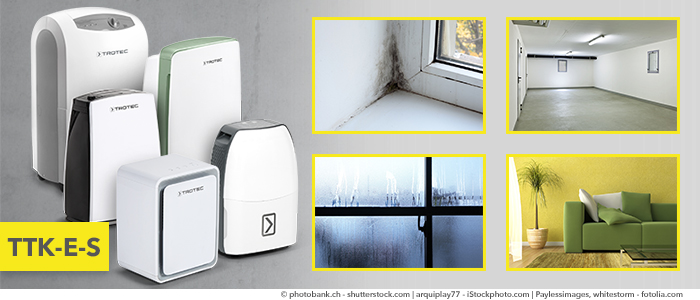Time and time again, many of our customers ask “Why is high air humidity in the house actually a problem?” The answer is simple: because excessive air humidity rapidly increases the danger of highly-unhealthy mould growth in the living areas. Either thorough ventilation or professional dehumidification can help here – but it is more difficult to answer the question as to the causes for the excessive air humidity…
A key problem of excessive air humidity is the risk of mould growth. Experts are unanimous in saying that this risk increases considerably above 70% relative air humidity, and they calculated that from 40% to 65% is the optimum air humidity for a person’s living environment. The problem is that such an optimum state does not readily occur all on its own. And at the latest when the dreaded black mould stains appear on the window reveals and the brickwork, the question poses itself: How could this happen?
The answer can be found in the explanation of the so-called ‘dew point’: Because the air can only store a certain amount of water vapour. With increasing temperature the air can absorb more humidity, with reducing temperature it stores less humidity. If the air cannot absorb any more water vapour, the so-called dew point is reached. After falling below this dew point, the water vapour starts to precipitate in the form of small droplets. In the house, this primarily takes place in the coolest places in the room. These can include uninsulated ceilings, window reveals or walls with thermal bridges. And mould finds its ideal nesting place in precisely these moistened places. Therefore it is important to know the main cause of excessive air humidity – and to avoid this.
The main causes of excessive air humidity
- Window insulation that is ‘too good’
Nowadays, insulated windows are so well fitted into the window reveals with insulating material that not even the tiniest amounts of air can get in or out. In consequence, a continuous air exchange that would vent the damp air to the outside and replace it with drier air from outside can no longer take place in these rooms. - Incorrect ventilation
Having windows tilted open for longer periods should be avoided. This cools the adjacent walls and humidity precipitates at these points. Brief opening of windows should also be avoided. This only allows the humid air in the room to be exchanged to a limited degree. - Drying laundry in the home
Wherever water is present in the home, air humidity is increased – that is, when washing, showering, bathing, cooking, washing up, mopping and wiping. In particular,the drying of washing significantly increases air humidity.
What you can do to counteract high air humidity
The method of choice for dealing with high air humidity is ventilation. You should open the windows several times a day and ensure a strong draught. This is easiest to achieve in winter when temperatures are cold and the air outside is dry. Just a few minutes are enough to completely exchange the air. Air exchange is more difficult in summer when the exterior air is warm and humid but the interior rooms are still cool. If the windows are opened, the humid warm air enters – it then cools and the relative humidity increases rapidly. Here, the solution is to ideally ventilate in the cool morning hours.
Caution when ventilating cellars
Many house owners leave their cellar doors wide open all day in summer and are then surprised about the high increase in air humidity and soaking wet cellar walls. Here, the explanation is also that the warm air can store more water vapour. However, in summer the air in the cellar is usually cooler than outside. If fresh warm air enters the cellar, it cools and can then no longer hold the water vapour – the humidity then precipitates in the coldest parts of the cellar, usually on the walls. On the other hand, frosty cool weather is ideal for ventilating & drying cellars.
Summary: This is how you effectively counteract air humidity and mould
The best thing to do is to firstly orientate your actions against the relative air humidity in your rooms. To do this you will just need a hygrometer, or you could just reach for the BZ05 thermal hygrometer from Trotec. This device constantly measures and displays the two determining factors for your personal feel-good atmosphere – air temperature and air humidity.
If the air humidity is too high, you should first try to reduce the humidity by following our tips for correct ventilation. If this is unsuccessful, or if you simply do not manage to thoroughly ventilate often enough, you should rely on professional support from Trotec TTK Comfort dehumidifiers. You can find a suitable model for almost all applications in our comprehensive range. Thanks to their innovative technology, such as hygrostat-controlled automatic dehumidification, these devices are effective when it comes to keeping rooms dry. All TTK devices can be used with flexibility thanks to their mobility and compact design and also prove convincing with a wide range of other convenient equipment features.
Rely on the innovative solutions from Trotec
Find out all about the advantages offered to you by our TTK Comfort Series dehumidifiers. And also take advantage of our current offer: The BZ05 thermal hygrometer for just £10.57 instead of £16.28 incl. VAT or, in combination with a dehumidifier, for an additional charge of just £10 incl. VAT – now on sale in the Trotec shop!


